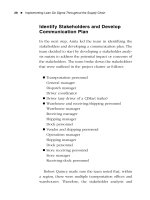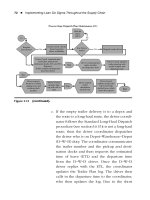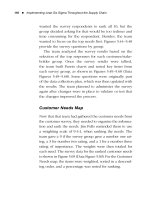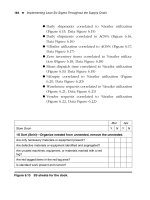Subprime mortgage credit derivatives by thomas a zimmerman and frank j fabozzi
Bạn đang xem bản rút gọn của tài liệu. Xem và tải ngay bản đầy đủ của tài liệu tại đây (2.04 MB, 336 trang )
Subprime
Mortgage
Credit
Derivatives
LAURIE S. GOODMAN
SHUMIN LI
DOUGLAS J. LUCAS
THOMAS A. ZIMMERMAN
FRANK J. FABOZZI
John Wiley & Sons, Inc.
ffirs.indd iii
5/7/08 12:10:56 AM
Copyright © 2008 by John Wiley & Sons, Inc. All rights reserved.
Published by John Wiley & Sons, Inc., Hoboken, New Jersey.
Published simultaneously in Canada.
No part of this publication may be reproduced, stored in a retrieval system, or transmitted in any form or by any means, electronic, mechanical, photocopying, recording, scanning, or otherwise, except as permitted under Section 107 or 108 of the 1976 United States
Copyright Act, without either the prior written permission of the Publisher, or authorization
through payment of the appropriate per-copy fee to the Copyright Clearance Center, Inc., 222
Rosewood Drive, Danvers, MA 01923, (978) 750-8400, fax (978) 646-8600, or on the web
at www.copyright.com. Requests to the Publisher for permission should be addressed to the
Permissions Department, John Wiley & Sons, Inc., 111 River Street, Hoboken, NJ 07030,
(201) 748-6011, fax (201) 748-6008, or online at />Limit of Liability/Disclaimer of Warranty: While the publisher and author have used their
best efforts in preparing this book, they make no representations or warranties with respect
to the accuracy or completeness of the contents of this book and specifically disclaim any
implied warranties of merchantability or fitness for a particular purpose. No warranty may
be created or extended by sales representatives or written sales materials. The advice and
strategies contained herein may not be suitable for your situation. You should consult with a
professional where appropriate. Neither the publisher nor author shall be liable for any loss
of profit or any other commercial damages, including but not limited to special, incidental,
consequential, or other damages.
For general information on our other products and services or for technical support, please
contact our Customer Care Department within the United States at (800) 762-2974, outside
the United States at (317) 572-3993, or fax (317) 572-4002.
Wiley also publishes its books in a variety of electronic formats. Some content that appears in
print may not be available in electronic books. For more information about Wiley products,
visit our web site at www.wiley.com.
Library of Congress Cataloging-in-Publication Data:
Subprime mortgage credit derivatives / Laurie S. Goodman ... [et al.].
p. cm.—(The Frank J. Fabozzi series)
Includes index.
ISBN 978-0-470-24366-4 (cloth)
1. Mortgage loans—United States. 2. Mortgage loans—United
States—Statistics. 3. Secondary mortgage market—United States. I.
Goodman, Laurie S.
HG2040.15.S825 2008
332.63’244—dc22
2008014507
Printed in the United States of America.
10 9 8 7 6 5 4 3 2 1
ffirs.indd iv
5/7/08 12:10:57 AM
LSG
To my husband Mark, and my children
Louis, Arthur, Benjamin, and Pamela
SL
To my wife Lisa, my children Alexander and Oliver,
and my dog Sassafras
DJL
To my wife Elaine, and my children
Eric and Benjamin
TAZ
To my wife Nanci, and my children
Alexander and Gregory
FJF
To my wife Donna, and my children
Francesco, Patricia, and Karly
ffirs.indd v
5/7/08 12:10:57 AM
Contents
Preface
xiii
About the Authors
xv
PART ONE
Mortgage Credit
CHAPTER 1
Overview of the Nonagency Mortgage Market
Issuance Volumes
Roots of the 2007–2008 Subprime Crisis
Defining Characteristics of Nonagency Mortgages
Loan Characteristics
Risk Layering
Agency versus Nonagency Execution
Summary
CHAPTER 2
First Lien Mortgage Credit
Concepts and Measurements of Mortgage Credit
Collateral Characteristics and Mortgage Credit:
Assault of the Four Cs in 2006 (Credit, Collateral,
Capacity, and Character)
The End Game: Foreclosure, REO Timeline, and Severity
The Role of Unobservable in 2006 Subprime Mortgage Credit
1
3
5
5
9
9
18
22
23
27
28
35
46
62
CHAPTER 3
Second Lien Mortgage Credit
73
Two Types of Seconds
Higher Risks in Seconds
Recent Performance
73
75
80
vii
ftoc.indd vii
5/7/08 12:14:00 AM
viii
CONTENTS
Why Higher Losses?
Summary
80
81
PART TWO
Mortgage Securitizations
87
CHAPTER 4
Features of Excess Spread/Overcollateralization:
The Principle Subprime Structure
89
Excess Spread-Based Credit Enhancement
OC in Alt-A-Land
OC Internal Workings
Summary
90
97
103
110
CHAPTER 5
Subprime Triggers and Step-Downs
The Step-Down and the Trigger
BBB Stack (on the Knife’s Edge)
Effect of Triggers and the Loss Waterline
Sampling the Subprime Universe
2000–2003 Deal Step-Down Summary
Step-Down and Credit Effects
Summary
111
111
116
117
118
118
119
122
PART THREE
Credit Default Swaps on Mortgage Securities
CHAPTER 6
Introduction to Credit Default Swap on ABS CDS
Corporate CDS Fundamentals and Terminology
Differences Between Corporate CDS and ABS CDS
Difficulties in ABS CDS
ABS CDS Effect on ABS CDO Management
Two New Types of ABS CDOs
Summary
ftoc.indd viii
123
125
125
128
131
141
142
143
5/7/08 12:14:01 AM
Contents
CHAPTER 7
The ABX and TABX Indices
Background
How a Deal Gets into the Index
Index Mechanics
Index Pricing Over Time
ABX Tranche Trading
TABX Pricing
TABX versus CDOs
Summary
CHAPTER 8
Relationship among Cash, ABCDS, and the ABX
Fundamental Contractual Differences—
Single-Name ABCDS/ABX Index/Cash
Supply/Demand Technicals
What Keeps the Arbitrage from Going Away?
Summary
Appendix: Importance of ABCDS to CDO Managers
CHAPTER 9
Credit Default Swaps on CDOs
CDO CDS Nomenclature
CDO Credit Problems and their Consequences
Alternative Interest Cap Options
Miscellaneous Terms
Cash CDO versus CDO CDS
Exiting a CDO CDS
Rating Agency Concerns on CDOs that
Sell Protection via CDO CDS
Summary
ix
145
145
146
149
152
156
157
159
160
161
162
168
171
173
173
177
178
179
182
185
186
187
188
189
PART FOUR
Loss Projection and Security Valuation
CHAPTER 10
Loss Projection for Subprime, Alt-A, and Second Lien Mortgages
Two Ways of Projecting Loss
Default Timing
ftoc.indd ix
191
193
193
194
5/7/08 12:14:01 AM
x
CONTENTS
Steps in Predicting Collatal Losses
Pros and Cons of the Default Timing Curve
Historical Model Fit versus Actual
Default Timing Is Not Equal to Loss Timing
An Alternative Specification
Alt-A and Closed-End Seconds
Summary
CHAPTER 11
Valuing the ABX
Review of Basic Valuation for ABX Indices
Review of Valuation Approaches
Econometric Approach
ABX Valuation
The “Simple” or Do-It-Yourself Approach to ABX Valuation
ABX After Subprime Shutdown
Summary
Appendix: Results of Original “Base” Pricing
(And Number of Bonds Written Down) and the
New “Shutdown” Estimates
CHAPTER 12
ABS CDO Losses and Valuation
The Mortgage Loan-Mortgage Bond-ABS CDO Chain
Mortgage Deal Losses
Subprime Mortgage Bond Losses
Alt-A, Second Lien, and Prime Mortgage Bond Losses
Aggregating Mortgage Bond Losses in
2006–7 Mezzanine ABS CDOs
Aggregating Mortgage Bond Losses in
2005 Mezzanine ABS CDOs
Drivers of CDO Losses and the Role of the Manager
ABS CDO Valuation and CDO Structure
Summary
ftoc.indd x
195
201
201
203
203
206
209
211
211
212
214
234
239
254
259
260
269
270
270
273
276
276
283
284
288
291
5/7/08 12:14:01 AM
Contents
xi
SECTION FIVE
Subprime Meltdown
CHAPTER 13
The Great Subprime Meltdown of 2007
An Earlier Subprime Crisis
The Virtuous Cycle
Early-Pay Defaults: The First Hint Things Were Changing
The 2006 Conundrum
Banking Regulators: Not Too Little but Too Late
Who Will Rescue the Subprime Borrower?
Is Securitization the Villain?
Lack of Transparency
Spillover
Future for Subprime
Index
ftoc.indd xi
293
295
296
299
301
303
308
312
312
316
317
317
319
5/7/08 12:14:01 AM
Preface
he purpose of this book is to explain subprime mortgage credit and its
numerous derivative instruments. We cover the determinants of mortgage
credit, mortgage securitization, and all the derivatives of mortgage credit
(that is, credit default swaps, the ABX and TABX indices, and credit default
swaps on mortgage-backed CDOs). Moreover, we provide methodologies
for projecting losses for a pool of mortgage loans and present models for
the valuation of mortgage securitizations and derivatives of mortgage securitizations.
The 13 chapters of this book are divided into five parts:
T
Part One: Mortgage Credit
Part Two: Mortgage Securitizations
Part Three: Credit Default Swaps on Mortgage Securities
Part Four: Loss Projection and Security Valuation
Part Five: The Subprime Meltdown
In Part One, we look at the underlying determinants of mortgage credit.
This topic is essential for understanding the topics covered in the other four
parts of the book. Chapter 1 provides an overview of the nonagency mortgage market. We look at the defining characteristics of jumbo prime, Alt-A,
and subprime mortgages, describing how those characteristics have changed
over time. In Chapter 2, we focus on first lien mortgages, paying particular
attention to collateral characteristics. In addition, we describe the mortgage
credit end game: The timeline from delinquency to foreclosure to real estate
owned (REO) and the determination of loss severities. Our focus in Chapter 3 is on second lien mortgages where we provide intuition as to why the
losses on such loans are so high.
In Part Two, we look at the structure of mortgage securitization. Credit
support features (excess spread, overcollateralization, and subordination)
are explained. This standard subprime structure is used in many Alt-A deals
as well. In Chapter 5 we look at subprime triggers and stepdowns. These
structural mechanisms make a substantial difference in determining the size
and timing of cash flows to the various bond classes in a securitization transaction.
xiii
fpref.indd xiii
5/7/08 12:16:53 AM
xiv
PREFACE
We devote Part Three to credit default swaps on mortgage securities.
Chapter 6 provides an introduction to credit default swaps on asset-backed
securities, describing the differences between credit default swaps on assetbacked securities (ABCDS) and credit default swaps on corporate bonds.
Chapter 7 discusses the ABX and TABS indices. The importance of the ABX
indices is hard to overstate; price transparency in these indices provides guidance for cash instruments. The relationships between cash bonds, ABCDS,
and the ABX, including structural features and supply/demand technicals,
are explored in Chapter 8. In Chapter 9, we explain credit default swaps on
CDOs.
In Part Four we look at loss projection and securities valuation. The first
step in valuing these securities is to estimate losses on the underlying collateral. In Chapter 10 we discuss loss projection methodologies for subprime,
Alt-A, and second lien mortgages. In Chapter 11 we discuss ABX valuation
using the loss projection methodology described in Chapter 10 and then
extend the loss projection methodology to ABS CDOs in Chapter 12.
Part Five contains a single chapter: The great subprime meltdown of
2007. We discuss the roots of the market meltdown, as well as the future of
the subprime market.
In this book, we refer to a number of data services. First American
CoreLogic, LoanPerformance Data updates and maintains the database that
provides the foundation for much of the quantitative work in this book.
CPR & CDR Technologies, Inc. provides a front end for the LoanPerformance database. Intex Solutions, Inc. provides collateral data and deal modeling. Markit Group Limited provides pricing data for a variety of mortgage-related instruments.
We gratefully acknowledge the expertise and input of the following
members of the UBS Securitized Products Research Group: James Bejjani,
Christian Collins, Jeffrey Ho, Charles Mladinich, Trevor Murray, Laura
Nadler, Danny Newman, Greg Reiter, Susan Rodetis, Dipa Sharif, Wilfred
Wong, Victoria Ye, and Ke Yin. Their helpful discussions and ongoing support are appreciated. A special thanks is due Rei Shinozuka for his work in
this area and for his significant contributions to this book.
Laurie S. Goodman
Shumin Li
Douglas J. Lucas
Tom Zimmerman
Frank Fabozzi
fpref.indd xiv
5/7/08 12:16:54 AM
About the Authors
Laurie S. Goodman is co-head of Global Fixed Income Research and Manager of U.S. Securitized Products Research at UBS. Her Securitized Products
Team is responsible for publications and relative value recommendations
across the RMBS, ABS, CMBS and CDO markets. As a mortgage analyst,
Dr. Goodman has long dominated Institutional Investor’s MBS categories,
placing first in five categories 40 times over the last 10 years. In 1993, she
founded the securitized products research group at Paine Webber, which
merged with UBS in 2000. Prior to that, she spent 10 years in senior fixed
income research positions at Citicorp, Goldman Sachs, and Merrill Lynch,
and gained buy-side experience as a mortgage portfolio manager. She began
her career as a Senior Economist at the Federal Reserve Bank of New York.
Dr. Goodman holds a BA in Mathematics from the University of Pennsylvania and both MA and Ph.D. degrees in Economics from Stanford University. She has published more than 170 articles in professional and academic
journals.
Shumin Li is Executive Director of MBS/ABS Strategy and Research at UBS
Investment Bank in New York. Prior to joining UBS in 2006, he worked at
Credit Suisse and GMAC-RFC as a Vice President and Senior Analyst on
residential mortgage-related research that includes prepayment and default
modeling, structuring, and relative value analysis. From 2000 to 2004, Mr.
Li worked at Fannie Mae as a Senior Financial Engineer where he was responsible for developing prepayment models of all mortgage products at the
company. He started his career in the financial industry in 1998 working
as a Quantitative Analyst at FleetBoston Financial Group in Providence,
Rhode Island. Mr. Li has a master’s degree in economics from Brown University and a bachelor’s degree in economics from Peking University.
Douglas Lucas is an Executive Director at UBS and head of CDO Research.
His team consistently ranks in the top three of Institutional Investor’s fixed
income analyst survey. His prior positions include head of CDO research
at JPMorgan, co-CEO of Salomon Swapco, credit control positions at two
boutique swap dealers, and structured products and security firm analyst
at Moody’s Investors Service. Mr. Lucas also served two terms as Chair-
xv
flast.indd xv
5/7/08 12:18:25 AM
xvi
ABOUT THE AUTHORS
man of The Bond Market Association’s CDO Research Committee. While
at Moody’s from 1987 to 1993, he authored the rating agency’s first default
and rating transition studies, quantified the expected loss rating approach,
and developed Moody’s rating methodologies for collateralized debt obligations and triple-A special purpose derivatives dealers. He is also known for
doing some of the first quantitative work in default correlation. Mr. Lucas
has a BA magna cum laude in Economics from UCLA and an MBA with
Honors from the University of Chicago.
Thomas A. Zimmerman is Managing Director and Head of ABS and mortgage credit research in the Securitized Products Strategy Group at UBS.
Prior to joining UBS, he spent eight years at Prudential Securities, first as a
Senior VP in the Mortgage Research Group and later as head of the ABS Research Department. Before that, he managed the MBS/ABS Research Group
at Chemical Bank. Mr. Zimmerman started his research career as a Vice
President in the Mortgage Research Department at Salomon Brothers. His
research has appeared in numerous fixed income publications and industry
reference works, including the Handbook of Fixed Income Securities and
the Handbook of Mortgage-Backed Securities. He is a member of the UBS
research team that consistently ranks in the top three of Institutional Investor’s fixed income analyst survey. Mr. Zimmerman earned a BS in Management Science from Case Western Reserve University and an MS in Operations Research from the University of Southern California.
Frank J. Fabozzi is Professor in the Practice of Finance and Becton Fellow
in the School of Management at Yale University. Prior to joining the Yale
faculty, he was a Visiting Professor of Finance in the Sloan School at MIT.
Professor Fabozzi is a Fellow of the International Center for Finance at Yale
University and on the Advisory Council for the Department of Operations
Research and Financial Engineering at Princeton University. He is an affiliated professor at the Institute of Statistics, Econometrics and Mathematical
Finance at the University of Karlsruhe (Germany). He is the editor of the
Journal of Portfolio Management and an associate editor of the Journal of
Fixed Income. He earned a doctorate in economics from the City University
of New York in 1972. In 2002, Professor Fabozzi was inducted into the
Fixed Income Analysts Society’s Hall of Fame and is the 2007 recipient of
the C. Stewart Sheppard Award given by the CFA Institute. He earned the
designation of Chartered Financial Analyst and Certified Public Accountant. He has authored and edited numerous books about finance.
flast.indd xvi
5/7/08 12:18:25 AM
PART
One
Mortgage Credit
p01.indd 1
5/6/08 11:22:58 PM
CHAPTER
1
Overview of the
Nonagency Mortgage Market
n this chapter we look at the major types of nonagency mortgage product, along
with their defining characteristics and the variation in issuance volumes.
The value of residential 1–4 family real estate in the United States is
$23 trillion. Against this, there is $10.7 trillion in mortgage debt, with the
remaining 53% ($12.3 trillion) representing homeowner equity. That equity
value is created because either a homeowner has no mortgage on their home,
or the home’s value exceeds the mortgage (via any combination of mortgage
paydown, home price appreciation, or loan-to-value mortgage issuance).
Of the $10.7 trillion in residential mortgage debt, $6.3 trillion (58%)
has been securitized. The securitized portion can be broken down into
agency mortgages and nonagency mortgages. Agency mortgages are those
guaranteed by either the Government National Mortgage Association (Ginnie Mae), a U.S. government agency, or one of the government-sponsored
enterprises (GSEs), Fannie Mae or Freddie Mac. Nonagency mortgages are
mortgages that, for a variety of reasons, do not meet underwriting criteria
required by the agencies. Mortgages that fail to meet the underwriting standards of the agencies are said to be nonconforming mortgages.
Exhibit 1.1 shows that in 2007, agency mortgages represented approximately 66% of the securitized market, with the remaining 34% consisting
of nonagency mortgages. The nonagency share contains jumbo prime (8%
of the total), alternative-A or Alt-A (13%), and subprime (13%). While we
will discuss in more detail later, jumbo prime mortgages are those whose
are too large in size in qualify for Ginnie Mae, Fannie Mae, or Freddie Mac
programs. Alt-A mortgages and subprime mortgages generally have more
risk layering than standard agency mortgage-backed securities (MBS), while
subprime borrowers are generally lower in credit quality than the borrowers
backing agency MBS. On the nonsecuritized portion of the market, we do not
have any information on the distribution of outstandings. (We do not know
what percentage is prime, subprime, and Alt-A, which explains why market
participants have seen widely divergent estimates on component sizes.)
I
3
c01-Overview.indd 3
5/6/08 11:30:22 PM
4
c01-Overview.indd 4
5/6/08 11:30:24 PM
417,216
2007-Q2
1,585,752
1,468,608
1,321,268
1,193,683
1,129,540
1,066,303
940,933
816,602
744,619
643,465
576,846
551,513
512,238
460,656
434,499
401,525
FHLMC
2,145,723
2,026,107
1,881,435
1,832,535
1,790,743
1,708,409
1,442,230
1,197,298
1,097,707
977,708
854,782
801,025
735,170
681,237
638,780
560,471
FNMA
4,148,691
3,904,911
3,607,949
3,467,453
3,394,021
3,312,600
2,974,531
2,625,453
2,424,589
2,158,604
1,968,438
1,858,878
1,719,691
1,592,827
1,487,345
1,381,512
Total Agency
Note: Estimates in italics.
Source: Inside MBS & ABS, LoanPerformance, and UBS.
410,196
591,368
2001
2006
611,553
2000
405,246
582,263
1999
2005
537,431
1998
441,235
536,810
1997
2004
506,340
1996
473,738
472,283
1995
2003
450,934
1994
537,888
414,066
2002
419,516
1993
GNMA
1992
Year
EXHIBIT 1.1 Outstanding Mortgage Securities
2,120,175
1,991,459
1,536,627
1,049,767
664,005
544,055
463,217
385,501
353,660
321,869
253,804
215,357
193,759
183,002
167,899
142,265
Nonagency
66%
66%
70%
77%
84%
86%
87%
87%
87%
87%
89%
90%
90%
90%
90%
91%
8%
13%
Prime
Subprime
13%
Alt-A
34%
34%
30%
23%
16%
14%
13%
13%
13%
13%
11%
10%
10%
10%
10%
9%
% Nonagency
% of Total MBS
% Agency
Out of the 34% Nonagency
6,268,866
5,896,370
5,144,576
4,517,220
4,058,026
3,856,655
3,437,748
3,010,954
2,778,249
2,480,473
2,222,242
2,074,235
1,913,450
1,775,829
1,655,244
1,523,777
Total MBS
10,749,703
10,359,047
9,323,217
8,284,980
7,226,763
6,436,575
5,677,996
5,126,531
4,699,578
4,274,301
3,917,569
3,682,790
3,459,184
3,291,540
3,113,834
2,954,396
1–4 Mtg.
Outstanding
Value of residential 1–4 family real estate: $23 Trillion
58%
57%
55%
55%
56%
60%
61%
59%
59%
58%
57%
56%
55%
54%
53%
52%
MBS as % of Total
Mtg. Outstanding
Overview of the Nonagency Mortgage Market
5
ISSUANCE VOLUMES
Exhibit 1.2 shows the main sectors of MBS that we discuss and their respective issuance volumes from 1995 to the third quarter of 2007. Note
that between 1995 and 2003, the agency share of mortgage issuance ranged
from 75% to 85%. The nonagency share (15% to 25%) was comprised of
jumbo, Alt-A, subprime, and “other,” with the jumbo prime share the largest portion.
The agency share of issuance dropped to 54% in 2004, and then further
to 45% in 2005 and 2006. The declining agency share during from 2004 to
2006 was accompanied by a large increase in subprime and Alt-A issuance.
For example, the subprime share rose from 7% in 2003 to 19% to 22% in
2004 to 2006. The Alt-A share increased from 3% in 2003 to 15% to 18%
in 2005 and 2006.
ROOTS OF THE 2007–2008 SUBPRIME CRISIS
Therein lies the roots of the subprime crises. The decline in agency issuance
during 2004–2006, mirrored by a rise in subprime and Alt-A issuance, reflected the drop in housing affordability during this period. The reason for
the drop in housing affordability was a rise in interest rates from their mid2003 lows in conjunction with the continued rise in housing prices. Exhibit
1.3 shows the Freddie Mac Conventional Home Price Indices and the Case
Shiller Home Price Indices. Notice the large run-up in home price appreciation (HPA) during 2003–2005; we clearly see that housing became less and
less affordable.
The most commonly used measure of housing affordability is the National
Association of Realtors Housing Affordability Index. This index, shown in
Exhibit 1.4, measures the ability of a family earning the median income to
buy a median-priced home. This calculation is critically dependent on three
inputs: median family income, median home prices, and mortgage rates. It
assumes a family earning the median family income buys the median priced
home, puts down 20%, and takes out a 30-year conventional mortgage for
the remaining 80% of the house value at prevailing interest rates.1 If payments
on a 30-year conventional mortgage consume 25% of a borrower’s income,
then the index has a value of 100. Our sample calculation consists of:
Median family income = $60,000 per year; $5,000 per month
Median priced home = $224,000
Downpayment = 20% × $224,000 = $44,800
1
A conventional mortgage is one that is not guaranteed by an agency or governmentbacked insurance.
c01-Overview.indd 5
5/6/08 11:30:26 PM
6
c01-Overview.indd 6
5/6/08 11:30:26 PM
2,131,953
1,018,684
964,697
924,637
860,909
265,208
288,743
306,958
2003
2004
2005
2006
2007-9M
2007-Q1
2007-Q2
2007-Q3
38,206
100,916
96,873
235,995
365,676
332,323
158,586
74,151
53,463
11,374
16,444
12,023
21,236
6,518
1,803
498
Alt-A
74,694
26,216
40,290
88,554
189,464
448,600
465,036
362,549
194,959
122,681
87,053
52,467
55,852
75,830
56,921
30,769
17,772
Subprime
60,567
60,333
161,190
219,037
280,704
233,378
237,455
171,534
142,203
53,585
74,631
97,365
49,975
31,419
25,838
Jumbo
Nonagency ($ million)
Source: Inside MBS & ABS and UBS.
1,444,426
2002
685,078
1999
479,011
725,952
1998
1,087,499
367,884
1997
2001
370,648
2000
269,132
1996
Agency
($ million)
1995
Date
EXHIBIT 1.2 MBS Gross Issuance
15,472
22,288
26,148
63,908
112,139
113,247
109,639
79,653
66,277
26,691
13,463
5,394
8,780
5,719
5,903
4,818
Other
427,142
547,207
537,116
1,511,465
2,070,089
2,156,007
1,882,836
2,718,170
1,858,381
1,354,819
614,970
832,977
929,163
487,016
440,541
318,058
Total MBS
($ million)
71.9
52.8
49.4
57.0
44.7
44.7
54.1
78.4
77.7
80.3
77.9
82.2
78.1
75.5
84.1
84.6
Agency
8.9
18.4
18.0
15.6
17.7
15.4
8.4
2.7
2.9
0.8
2.7
1.4
2.3
1.3
0.4
0.2
Alt-A
9.4
11.1
11.2
10.7
10.6
13.0
12.4
8.7
9.2
10.5
8.7
9.0
10.5
10.3
7.1
8.1
6.1
13.6
16.5
12.5
21.7
21.6
19.3
7.2
6.6
6.4
8.5
6.7
8.2
11.7
7.0
5.6
Subprime
% of Total
Jumbo
3.6
4.1
4.9
4.2
5.4
5.3
5.8
2.9
3.6
2.0
2.2
0.6
0.9
1.2
1.3
1.5
Other
28.1
47.2
50.6
43.0
55.3
55.3
45.9
21.6
22.3
19.7
22.1
17.8
21.9
24.5
15.9
15.4
Nonagency
7
Overview of the Nonagency Mortgage Market
EXHIBIT 1.3 Home Price Indices
25%
20%
FH
Annual
15%
10%
5%
FH Quarterly
Annualized
0%
–5%
FH Quarterly Annualized
Mar-09
Mar-07
Mar-05
Mar-03
Mar-01
Mar-99
Mar-97
Mar-95
Mar-93
Mar-91
Mar-89
Mar-87
Mar-85
Mar-83
Mar-81
Mar-79
Mar-77
Mar-75
–10%
Case-Shiller Annual
Case-Shiller Annual
FH Annual
Note: Latest data: Q2 2007; quarterly FH annualized = 0.4%; FH annual = 3.3%;
CS Annual = –3%.
Source: Freddie Mac.
EXHIBIT 1.4 Housing Affordability versus 30-year Mortgage Rates
4
150
5
6
130
7
8
120
9
110
10
100
90
Jan-87
Housing Affordability
30-yr. Mtg. Rates
30-year Mortgage Rate
Housing Affordability
140
11
12
Jan-90
Jan-93
Jan-96
Jan-99
Jan-02
Jan-05
Note: Latest is estimated: August 2007; housing affordability = 106.1; 30-year
mortgage rate = 6.57%.
Source: National Association of Realtors and Freddie Mac.
c01-Overview.indd 7
5/6/08 11:30:27 PM
8
MORTGAGE CREDIT
Mortgage = 80% × $224,000 = $179,200
Mortgage rate = 6.50%
Mortgage payment 30-year fixed rate mortgage
= $1,133 ($179,200 mortgage at 6.5%)
So the National Association of Realtors’ calculation is:
25% of Median family income/Mortgage payment on median-priced home
= 25% × $5,000/$1,133 = 110.3
Home prices rose during the 2001–2003 period, but that rise was offset
by the drop in interest rates, leaving housing affordability in the range of
129 to 146. However, mortgage rates rose from late 2003 through 2006,
and housing values also rose, thus producing a sharp drop in housing affordability to a low of 99.6 by June 2006.
In order to maintain market share, originators began to relax origination standards. Combined loan-to-value ratios (CLTVs) rose (indicating a
heavy use of second mortgages), the interest-only share rose, and documentation dropped. In the next section of this chapter, we examine the loan
characteristics of jumbo, Alt-A, and subprime sectors, and quantify the drop
in origination standards.
The fall in the agency share between 2004 and 2006 reflected that:
1. Fannie Mae and Freddie Mac were slow to embrace “affordability”
products such as interest-only loans (IOs).
2. Both GSEs were reluctant to guarantee loans too far down the credit
spectrum, and reluctant to guarantee mortgages with too much risk
layering.
3. Even when agency execution was possible, agency risk-based pricing
resulted in execution that was usually worse than nonagency execution.
Thus, most of the mortgage affordability products received nonagency
execution. But subsequently in 2007 when nonagency execution channels
became more costly, originators again sought agency execution.
The relaxation in origination standards was fine as long home prices
were appreciating. When a borrower ran into difficulty, selling the home at
a profit was a much better option than defaulting. However, in mid-2006
housing began to weaken. Existing home sales fell; home prices were stagnant and then began to decline. Vacant homes for sales hit a multiyear high
and delinquencies began to rise.
c01-Overview.indd 8
5/6/08 11:30:30 PM
Overview of the Nonagency Mortgage Market
9
In 2007, as the subprime crises emerged and intensified, the agency share
rose, while subprime and Alt-A shares fell. During 2007, it had become
very difficult to obtain a subprime or Alt-A mortgage. Origination capacity was cut considerably. Most subprime originators without deep-pocketed parent companies went out of business, and either ceased operations
or were acquired. Moreover, even the remaining originators made very few
subprime and Alt-A loans, as the securitized markets for these products
had dried up. Investors who had historically purchased securities backed by
pools of subprime and Alt-A mortgages were no longer willing to purchase
the securities, at least not at rate levels that borrowers could afford to pay.
Thus, originators had no one to sell the loans to and did not have the balance sheet capacity to warehouse these loans. As a result, many originators
stopped making loans that did not qualify for agency guarantees and by
mid-2007 the mortgage market was again dominated by the agencies.
DEFINING CHARACTERISTICS OF NONAGENCY MORTGAGES
Exhibit 1.5 presents the main characteristics of different sectors of the agency and nonagency market. It covers such loan and borrower characteristics
as loan size, average FICO score, average LTV and CLTV, occupancy (owner versus investor), documentation (full versus nonfull), loan purpose (cashout, cash-out refi, or rate refi), the percent in adjustable rate mortgages, the
IO percent, and debt-to-income (DTI) ratio.
The nonagency sectors of the MBS market are defined by how they differ
from agency collateral. Jumbo prime mortgages generally have higher FICO
scores than agency mortgages. However, their main distinguishing characteristic is size; these loans exceed the conforming sized limit, $417,000 in
2007. The Alt-A loans may be conforming or nonconforming in terms of
size. These mortgages tend to be of good credit as measured by their FICO
score (approximately 710). Their distinguishing characteristic is the low
percentage (23%) of borrowers who fully document their income. The distinguishing characteristic of subprime borrowers is their FICO score; averaging in the 620s, it is much lower than other borrower types.
LOAN CHARACTERISTICS
These loan characteristics collectively determine the prepayment and credit
performance of each MBS deal. We now look at these characteristics in
greater detail.
c01-Overview.indd 9
5/6/08 11:30:30 PM
10
MORTGAGE CREDIT
EXHIBIT 1.5 Loan and Borrower Characteristics by Product Type
Agency
Jumbo Prime
Alt-A
Subprime
Lien
1st
1st
1st
1st
Loan limit
≤ Agency
> Agency
None
None
Average loan size
221,301
509,913
293,719
185,451
2006 Avg. loan size
230,403
577,022
320,828
210,472
Credit
Agency
A
A/A–
A–/C
Average FICO
725
739
712
628
2006 Avg. FICO
723
740
708
626
Average LTV
71
69
74
81
2006 Avg. LTV
73
71
75
81
Average CLTV
—
71
80
86
2006 Avg. CLTV
—
75
82
87
Occupancy (owner)
95%
99%
85%
95%
Full documentation
—
50%
23%
60%
Purchase
39%
46%
46%
40%
Cash out
59%
23%
36%
53%
30%
18%
7%
Loan purpose
Rate refi
IO
9%
45%
43%
20%
ARMs
12%
52%
63%
73%
DTI
—
33%
36%
41%
Source: Fannie Mae, Freddie Mac, and LoanPerformance.
Combined Loan-to-Value Ratio
The CLTV ratio is the single most important factor determining credit
performance on a loan. The loan-to-value (LTV) ratio refers to the loan
amount divided by the value of a home. Thus, if there is a $160,000 loan
(mortgage) on a $200,000 home, we would say the LTV ratio is 80%
($160,000/$200,000). The CLTV ratio is the sum of the first and second
mortgages divided by the home’s value. Thus, if there is a $160,000 first
mortgage and a $30,000 second mortgage] against a $200,000 home value,
we would say the borrower has a CLTV ratio of 95% ($190,000 mortgages/$200,000 value of home).
c01-Overview.indd 10
5/6/08 11:30:30 PM
Overview of the Nonagency Mortgage Market
11
EXHIBIT 1.6 2006–2007 CLTV Distribution
35%
30%
Frequency
25%
20%
15%
10%
5%
0%
20 25 30 35 40 45 50 55 60 65 70 75 80 85 90 95 100 105 110 115 120
CLTV
Alt-A
Subprime
Jumbo
Source: LoanPerformance.
A high CLTV typically indicates that the buyer has stretched to buy a
home, and could not put down as much as other borrowers. A high CLTV
is often associated with a high DTI ratio as well as other weak credit indications.
In the agency world, any loan that exceeds 80% LTV requires private
mortgage insurance (PMI). In the nonagency world, higher risk mortgages
such as subprime and Alt-A typically have higher LTVs than is seen in agency
pools. Exhibit 1.6 shows a distribution of the CLTVs on 2006 and 2007
jumbo, subprime, and Alt-A pools. Note that in both Alt-A and subprime
pools there is a considerable percentage of loans with CLTVs in excess of
95%. Note also that this percentage is higher in subprime pools than in
Alt-A pools.
Loans with higher CLTV ratios have higher delinquencies and higher
loss severities. Those delinquencies and loss severities increase due to home
price depreciation. Assume that a $200,000 house drops in value by 10%
and is thus worth only $180,000. The borrower with a $160,000 first mortgage and a $30,000 second mortgage (mortgages total $190,000) will have
little reason not to default on that home. The more the home depreciates in
value, the higher the loss severity.
It is also important to realize that in a lower home price appreciation
environment, loans with higher CLTV ratios will prepay more slowly, as
they have fewer refinancing opportunities.
c01-Overview.indd 11
5/6/08 11:30:31 PM
12
MORTGAGE CREDIT
FICO Scores
Credit scores have been used in the consumer finance industry for several
decades. Over the past decade, they have become an increasingly important
part of assessing mortgage credit.
A credit score is an empirically derived quantitative measure of the likelihood that a borrower will repay a debt. Credit scores are generated from
models that have been developed from statistical studies of historical data,
and use as inputs details from the borrower’s credit history. FICO scores are
tabulated by an independent credit bureaus, using a model created by Fair
Isaac Corporation (FICO). These scores range from 350 to 900, with higher
scores denoting lower risk.
FICO scores have been shown to play an important role in determining
both delinquencies and prepayment speeds. Lower FICO mortgages default
at a much higher rate than their higher FICO counterparts, and exhibit
much higher losses. On the prepayment side, it has historically been the case
that lower FICO borrowers prepay much faster than higher FICO counterparts. That’s because a low credit borrower who stays current on consumer
and mortgage loans for a year may be able to refinance at a lower rate.
Thus, refinancing due to “credit curing” has historically been the source of
relatively high base-case speeds on subprime loans. In addition, many borrowers had refinanced as a way to tap into the equity on their home, which
had increased in value. With the subprime crisis limiting the availability of
credit to these borrowers, and home prices falling, voluntary prepayments
fell sharply in 2007. Providing a modest cushion, involuntary prepayments
(defaults are passed through as a prepayment) rose.
Moreover, lower FICO pools tend to be much less sensitive to changes
in interest rates. This reflects the fact that in a refinancing, lower credit borrowers face higher closing costs and points.
Exhibit 1.5 shows that the average FICO scores are 725, 739, 712, and
628 for agency, jumbo, Alt-A, and subprime, respectively. It’s important
to realize that FICO scores alone do not sufficiently define a loan. This is
clearly illustrated in Exhibit 1.7, which depicts the FICO distribution. Note
that approximately 18% of subprime loans have FICO scores that exceed
680, while 27% of the Alt-A loans have FICO scores that fall below 680.
Documentation
Documentation is generally defined as either full documentation (“full
doc”) or limited documentation. Full documentation generally involves the
verification of income (based on the provision of W-2 forms) and assets
(from bank statements). With limited documentation, either income or as-
c01-Overview.indd 12
5/6/08 11:30:31 PM
13
Overview of the Nonagency Mortgage Market
EXHIBIT 1.7 FICO Distribution
10%
9%
8%
Frequency
7%
6%
5%
4%
3%
2%
1%
0%
450
500
550
Alt-A
600
650
700
FICO Score
Subprime
750
800
850
Jumbo
Source: LoanPerformance.
sets are not verified. Limited documentation can take many forms, including
SISA (stated income, stated assets), NISA (no income (income not provided,
stated assets), No Ratio (income not provided, assets verified). Each originator has its own definition of limited documentation. Moreover, originators
differ considerably in the degree to which they attempt to ferret out stated
income borrowers that are clearly lying. Some originators verify employment for stated income borrowers; others do not. Some originators go a step
further and make sure the income is reasonable for the occupation specified;
others do not perform that step.
Limited documentation is the key feature in defining Alt-A product.
In fact, the Alt-A market originally arose to accommodate borrowers who
owned their own business and lacked traditional documentation such as
employment and income verification. Then, in the late 1990s, the agencies
began to accept limited documentation for borrowers with higher FICO
scores and lower LTVs, and the jumbo market followed suit. Note that the
limited documentation was historically accompanied by compensating factors. However, from 2004 to 2006, documentation standards were relaxed
considerably, without requiring any type of compensating factors.
Limited documentation loans tend to have higher default rates than full
documentation loans. Moreover, limited documentation tends to be highly
correlated with other risk factors (higher LTV, lower FICO, higher DTI).
Documentation alone tends to be of secondary importance as a determinant
of prepayment stability.
c01-Overview.indd 13
5/6/08 11:30:32 PM
14
MORTGAGE CREDIT
Loan Size
All agency loans for single family homes must be less than the conforming
loan limit of $417,000.2 The loan limit is reset annually, based on Octoberto-October changes, as measured by the Federal Housing Finance Board
(FHFB). Even though the limit is $417,000, the average loan size is much
smaller; by the third quarter of 2007 it was approximately $225,000 for
new origination.
Loans carrying agency credit and meeting all other agency credit criteria except size are referred to as jumbo prime loans. (Often they are refereed to as either “jumbo” or “prime”). The average size of jumbo loans is
$510,000. (However, that includes loans extended when the loan limit was
smaller; e.g., the loan size limit in 2003 was $322,700. The average loan size
for 2006 jumbo origination was $577,000.
Alt-A loans can be either conforming or nonconforming. Their average size of $294,000 falls midway between that of agencies and jumbos.
Approximately 25% (as measured by number) of Alt-A mortgages issued
in 2006, and 50% (as measured by balances) were nonconforming in terms
of size.
Subprime loans are typically similar in size to agency loans. However,
there is a substantial minority of loans that are nonconforming in terms of
size. Thus, 6% of subprime mortgages issued in 2006 (measured by number) and 20% (measured by balances) were nonconforming in terms of size.
This is clearly shown in Exhibit 1.8 which illustrates the size distribution of
jumbo, Alt-A, and subprime loans.
Loan size is important in understanding both delinquency and prepayment characteristics. Note that smaller loans are less prepayment-sensitive
than loans with larger balances. This reflects the fact that the fixed costs of
refinancing have a larger impact on smaller mortgages. Smaller loans also
tend to have higher losses than larger loans, reflecting the higher fixed costs
of liquidation.
Loan Purpose
Loan purpose can take one of three forms: purchase, refi, or cash-out refi.
Historically, loan purpose has not been that important in determining either default or prepayment behavior. However in the 2004–2006 period,
purchase loans had much more risk layering than did either refi or cash-out
refis. That is, borrowers stretched to buy their homes, and these purchase
loans were far more apt to have higher DTI ratios, higher CLTVs, and higher
proportions of second mortgages and interest-only or 40-year mortgages.
2
The limit is greater for 2–4 unit homes, and single family homes located in Alaska,
Hawaii, Guam, and the Virgin Islands.
c01-Overview.indd 14
5/6/08 11:30:32 PM









